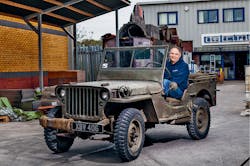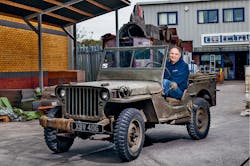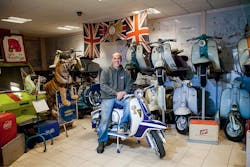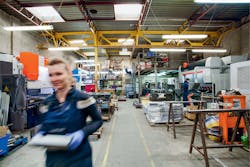Technology enables preservation of original details with efficiency
Crown Manufacturing (Weston-super-Mare, England) is a key supplier of shop fittings to the UK's leading sportswear, electrical-goods, and women's clothing retailers, in a country that spent €481 billion at almost 300,000 shops in 2016. The core of shop fitting work is cutting and bending metal—and speed, cost, and precision are what decide if a company will thrive in this competitive industry. Most recently, Crown replaced their Bystronic BySpeed CO2 laser with a faster BySprint Fiber 3015 laser cutter.
Crown's founder Dean Harvey is happy with this equipment (FIGURE 1). "I've had four lasers and four presses from Bystronic since 2004," he recounts. Operations manager Paul Read explains some of the features that they enjoy with a sheet of 16-gauge thick steel, where the BySprint's laser was programmed with BySoft to switch on and off at set intervals, rapidly filling the metal with "scan cuts" that make the most efficient use of the available material. Each fitting part can then be folded and snapped off by hand.
FIGURE 1. Dean Harvey, the founder of Crown Manufacturing, restores vehicles from the Second World War. (All photos courtesy of Andrea Artz)
Harvey shows off a curved piece that will become a shop's "click and collect" display unit. The custom curve required "bump radius" bends that were "like a dream, thanks to BySoft."
Crown considers its human resources carefully in the workshop and with trainees in the design department. There are apprenticeships of up to four years and in-house training of around a year. Operational management is decentralized to work teams. All staff are also rotated between machines, so there are always the needed skills to cover anyone away from work, as well as helping keep jobs interesting.
Beauty on two wheels
Next door to Crown is a company called Scootopia, dedicated to the seductive curves and sparkling chrome of the Italian Lambretta (FIGURE 2). Against one long wall is a double row of perhaps perfectly restored vehicles. The colors are cream, pistachio green, and an almost-fluorescent orange—each laser color-matched to what they would have been, and even sourced from the still-surviving original paint supplier in Italy. National variation is on display, as franchises from Argentina to India have made their own versions of the Lambretta over the years.
FIGURE 2. The Scootopia showroom, where the Lambrettas are Crown Manufacturing's greatest pride.
Like British culture, the world's scooter fraternity, for whom Scootopia is indeed a mecca, could be called perseverant and sometimes obsessive. They must persevere because the vehicles that they love were built up to a half-century ago, and so require attention to keep purring along. Dan Hodgett tells how "their obsession can find an outlet over the quality of paintwork, for example." But since Innocenti, the Italian company that made Lambrettas, closed in 1971, Scootopia has increasingly become the focus for that obsession.
Harvey's Scootopia uses the same Bystronic equipment to make a full range of Lambretta parts that can be seen in corridors of neatly laser-cut shelves, ready for sale around the world online. Hodgett explains how their reputation for scooter restoration grew regionally, then nationally, and now globally to the booming business it is. "Have scooters come back?" Hodgett considers. "No, because they never really went away."
Inputs that matter
Crown, Scootopia, and another company, Joe's Motor Pool, operate in three distinct markets. There are three virtues, to varying extents, that have made the three lines of business successful.
The first is reliability. If Crown is awarded a shop fitting contract, many retail outlets may be stripped of their previous décor and awaiting the new fittings at a set moment, with only a tight window of time available for installation before they must be open again to the public. Crown's product must be ready to specifications when it is promised. Similarly, customers to whom it is a matter of importance will trust that the components sold by Scootopia or built into one of Joe's Jeeps or general-purpose amphibian (GPA) vehicles will function well and be as authentic as possible. All three companies are trusted.
The second virtue will often be vital for the companies to keep their promises. When necessary, they must be able to carry out their work at considerable speed, even as quality levels are maintained. It is Crown that most depends on speed to remain competitive, but all the companies need to maintain efficient ways of working. Naturally, another key form of competition is price, which makes cost control the third required virtue. Effective use of information technology might be considered a fourth virtue, though design and operational IT are also essential means with which to speed up work processes and reduce costly mistakes and human resource inputs.
The final is one that is difficult to build in, because it takes a certain type of person in the right working environment. All three businesses depend on a well-deserved reputation for attention to detail.
Bystronic plays its part in helping the companies achieve success in each of these five areas. Their laser cutting systems and press brakes are well known for reliability, but perhaps more important is the response that Bystronic's after-sales service team will always provide. Each generation of machine also works faster and potentially more economically, with the fiber laser achieving three times the cutting speed of CO2 machines as well as less spend on gas inputs. BySoft 7 is at the frontier of aiding design and operations through software. But though Bystronic hopes that they share the necessary attention to detail and offer products to facilitate just such a healthy obsession, this final ingredient is one that the customer must bring itself.
War heroes on four wheels
Upstairs from Scootopia is a workshop just as active as Crown's, Joe's Motor Pool, where the output is much larger, squarer vehicles than downstairs. The main business here is Jeeps, which the company can either restore or build from scratch (FIGURE 3). A trainee uses original Jeep blueprints while designing a replacement fuel tank. A welder pauses before returning to arc welding of a naked chassis, deliberately leaving rough welds and places what would now be considered unnecessary rivets where historically accurate. Perhaps they have switched corrosive mild steel to more-resilient Zintec blue steel.
FIGURE 3. Crown Manufacturing's core business is restoring old Jeeps, keeping them as true to the original as possible.
Harvey has "perhaps 60" Jeeps sitting by his house, he says, "of which about 10 are good to go." The second product at Joe's Motor Pool is GPAs, long transporters that could move through water or across land (FIGURE 4). Some 21,000 GPAs were turned out by the Henley factory, that once sat just yards from where Crown/Scootopia/Joe's is now. The rough treatment these received, including in the D-day Normandy landings, means that only around 100 are left. This rarity value, together with the need for fully sealing the vehicle and curving its body to reduce water resistance, means a finished one may go for £120,000 (over $159,000).
FIGURE 4. Crown Manufacturing keeps up with the times; to remain competitive, the company recently invested in a BySprint Fiber 3015 machine.
At first sight, the GPAs look like a self-indulgent excess for men who want giant war-nostalgia toys-not so. In February 2014, the area just inland from Weston, was subjected to severe flooding—the worst in living memory. Harvey's DUKW, a sort-of oversized GPA weighing more than 2 tons, became an all-purpose rescue and supply vehicle, and appreciated by the local government, who had nothing as versatile, as by the victims of the rising murky waters.
The roads we travel in life
Earlier, Harvey mentions in passing that both of his grandparents had worked in the Henley's factory that brought amphibious vehicle production to England in wartime. He agrees that it is the success of Bystronic-equipped Crown that allowed him and his colleagues to pursue fascinations formed in postwar teenage days.
Harvey understands the urge most of us have to turn their hand to more than one thing, even as they ensure that they do each thing well. Coaxing a throaty roar from his current favorite Jeep before he maneuvers it between a forklift truck and the tail fin of a scrapped Dakota airplane that again he was unable to resist at auction, he tells me that "you've got to enjoy what you do."
This article is adapted by David Belforte from an article written by freelance journalist Dan Whitaker that first appeared in BystronicWorld magazine.




